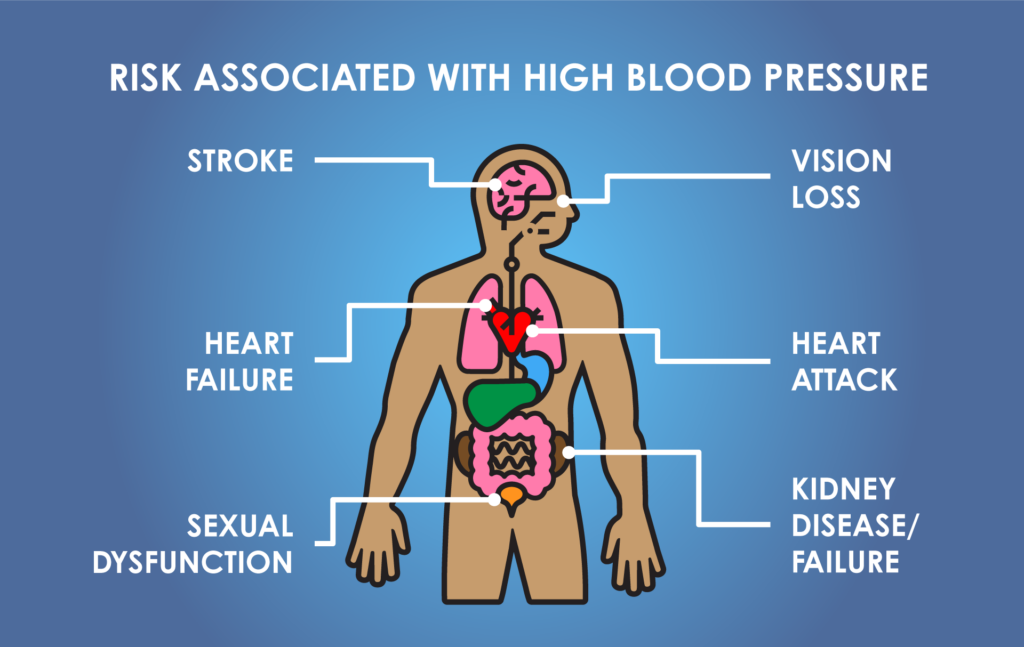What is blood pressure?
Blood pressure is the force, or pressure, of blood pushing against the walls of your arteries. Arteries carry blood from your heart to other parts of your body.
Your blood pressure normally rises and falls throughout the day.

Blood pressure measurements use two numbers:
The top number, called systolic blood pressure, is the pressure measured in your arteries while the heart is beating.
The bottom number, called diastolic blood pressure, is the pressure measured in your arteries when your heart is resting between heartbeats.
Blood pressure is measured in millimeters of mercury (mmHg). A normal blood pressure measurement is less than 120/80 mmHg.
What is High Blood Pressure or Hypertension?
High blood pressure, or hypertension, is diagnosed when the blood pressure is consistently higher than normal. Although blood pressure changes during activity and rest, blood pressure that is consistently higher than normal may indicate that you have high blood pressure or hypertension. High blood pressure can lead to other health problems such as heart disease, heart attack, stroke and other conditions.
High blood pressure is a common diagnosis – nearly 50% of adults in the United States have been diagnosed with hypertension (systolic blood pressure above 130 mmHg or diastolic blood pressure greater than 80 mmHg) or are taking medication for hypertension.


50%
Nearly ½ of adults in the US have high blood pressure
Only 1 in 4 adults with high blood pressure have their condition under control
More men (50%) have high blood pressure than women (44%)
Source – Center for Disease Control and Prevention (CDC)
High Blood Pressure Symptoms and Causes | cdc.gov Last accessed: 9/5/2023
Signs and Symptoms of High Blood Pressure
Few people have any signs or symptoms with high blood pressure. It can silently cause damage to your heart, brain, kidneys, blood vessels if not treated. Because of this, high blood pressure is often called a “silent killer.”
In some rare cases, people may have headaches, nosebleeds or feel dizzy.
Causes & Risk Factors for High Blood Pressure
Age – as we age, our blood vessels gradually lose elasticity over time which can increase the risk for high blood pressure.
Weight – being overweight places added stress on the body as the volume of blood being pumped through the blood vessels increases placing more pressure on the artery walls.
Race – high blood pressure is more common among Black American adults than in white, Asian or Hispanic American adults.
Physical activity – People who are inactive have higher blood pressure and heart rates.
Chronic health conditions – diabetes, sleep apnea, or kidney disease can affect blood pressure.
Gender – until age 64, men are more likely than women to have high blood pressure. After age 64, women are more likely to have high blood pressure.
Tobacco – smoking or chewing tobacco causes blood pressure to rise temporarily. Additionally, chemicals in tobacco can damage the lining of the artery walls causing them to narrow and increasing blood pressure.
Medications – medications taken for other health conditions, including common pain medications, antidepressants, hormones, and cold medications, can also affect blood pressure.
Family history – high blood pressure tends to run in families.
Diet – dietary choices, such as eating high sodium foods, can increase blood pressure.

How do I know if I have high blood pressure?
Because most people do not have symptoms, high blood pressure is often found during a visit to see a healthcare professional. Blood pressure is measured by placing a cuff around your arm that is inflated using a pressure-measuring gauge. Before diagnosing high blood pressure, your healthcare professional will likely measure your blood pressure during separate office visits. Because some people get anxious before an office visit and because blood pressure can vary through the day, you may be asked to check it at home between visits.
If your blood pressure is consistently 130/80 mmHg or higher, you will likely be diagnosed as having high blood pressure.
Blood pressure is classified in stages:

Your healthcare provider may order additional testing such as ambulatory blood pressure monitoring (ABPM), urine testing, or other tests to diagnose high blood pressure.
Source – National Heart lung and Blood Institute – High Blood Pressure – What Is High Blood Pressure | NHLBI, NIH Last accessed: 9/5/2023
